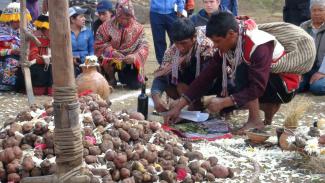
Indigenous communities—the planet’s first farmers—have always been at the forefront of agroecological practices. Even as they’ve been dispossessed of their land, they’ve sought to exercise food sovereignty, preserve biodiversity, and protect for future generations the territories they steward. On every continent, Indigenous Peoples resist the industrialized model of agriculture forced by colonization and globalization. Now, during the COVID-19 pandemic, they are leading recovery efforts, mobilizing mutual aid, and pressing for policy change. To strengthen these urgent and creative actions that safeguard community food security with healthy foods, the Agroecology Fund, a multidonor fund supporting agroecological practices and policies, lent support to 59 grassroots organizations around the world, many of them Indigenous-led. Here are just a few of their stories.
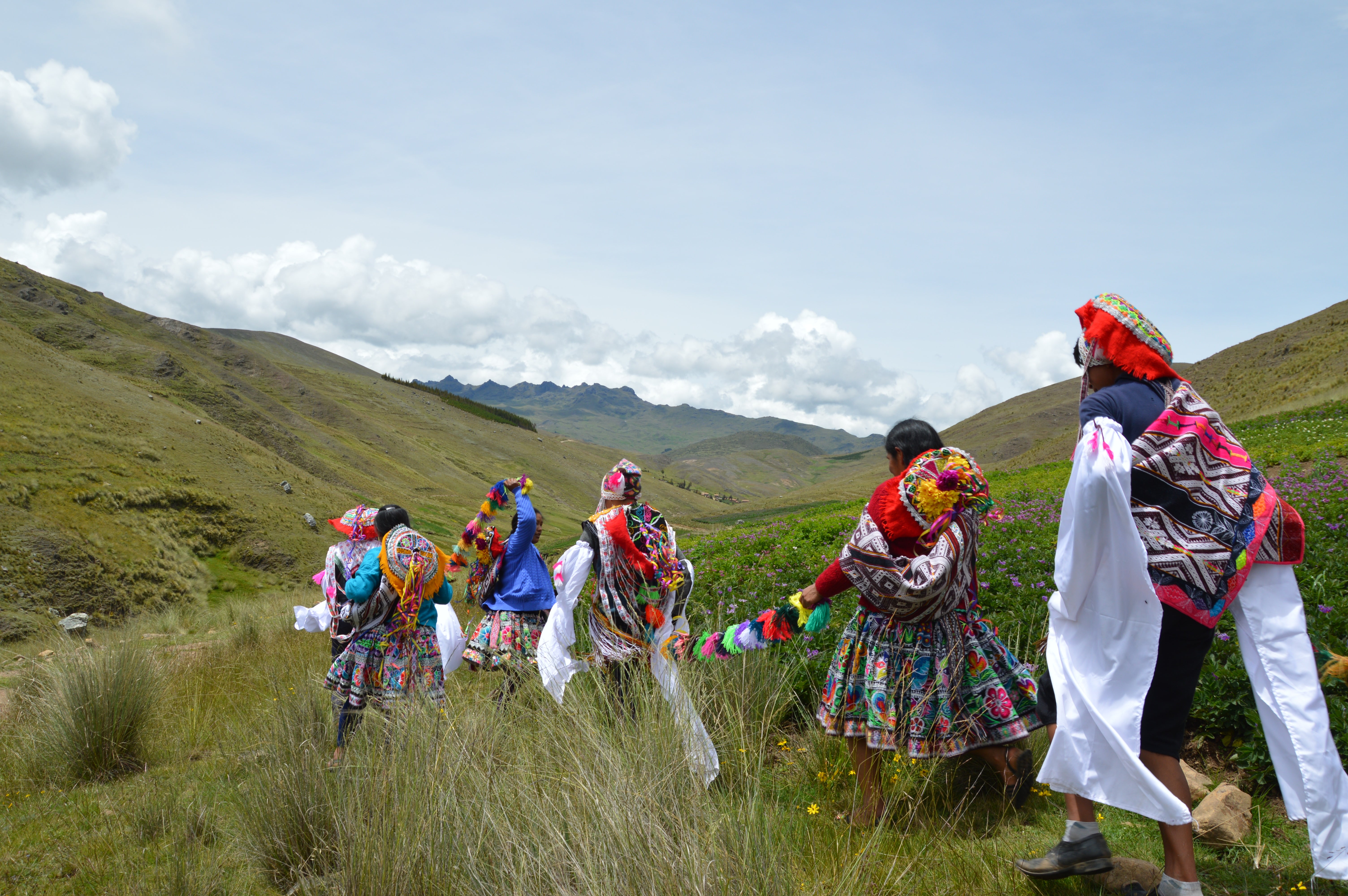
Photo courtesy of Potato Park.
The Americas
As the pandemic tore through South America, thousands of Peruvians fled the cities for their villages in the Andes and Amazon. With urban infection rates soaring and economic activities at a standstill, COVID-19 sparked a reversal of decades of urban migration. While life is difficult in the rural areas, communities there continue long-standing traditions of growing a diversity of food, and have remained protected from the most devastating effects of the pandemic. “Healthy lands produce healthy foods, and farming native crops is much better because we know these strengthen our immunity and resistance to diseases like COVID-19,” said Ricardina Pacco Condori, a local expert from the community of Paru Paru.
One of these areas is The Potato Park, a biocultural heritage territory located 3,300 meters above sea level in the district of Pisac, Cusco, Peru. Home to five Quechua communities (Amaru, Chawaytire, Pamapallaqta, Paru Paru, and Saccaca), the Potato Park conserves more than 1,300 varieties of potato, the greatest diversity of potato found anywhere in the world. By conserving Andean biodiversity, the Potato Park protects Indigenous rights and livelihoods. “We are working to prepare new chakras (farm plots) for planting, although we know that we will not have enough seeds to share with all these farmers who have returned. Still, we are very glad to see our young people returning and are excited for the opportunity to share our knowledge with the next generation,” said Nazario Quispe Amao, a local expert from the community of Chawaytire.
In a time of crisis, the ancestral values of solidarity, reciprocity, and balance lead to food security. These communities, with intact local food systems based on Indigenous values, have organized to respond to the crisis. On May 13, the Association of the Communities of the Potato Park distributed more than one tonne of native potatoes to returning migrants and other vulnerable groups in Cusco. Lorenzo Huayta Bayona, president of the Association, said that “the potatoes that we brought to our brothers and sisters who lack food in Cusco is a demonstration of Ayni, the Andean principle of solidarity and reciprocity that we have practiced since Incan times. Our food systems are profoundly connected to the principles of Ayllu (community), Ayni, and Chaninchay (equity), and these define our economy, health, and well being.”
Peru is blessed with a shining example of how to ensure food security in a time of crisis. Yet, for these Indigenous food systems to be the backbone of healthy food for the entire Peruvian population, dramatic changes in agricultural and food policies are required. The Peruvian State has demonstrated an increasing preference for agro-industry and high value commodity exports like artichoke, pomegranate, and blueberry, even as Peruvians in the city and country alike count on staple crops like potato, maize, and quinoa produced by smallholder and Indigenous farmers. These producers need and demand public support.
The pandemic has demonstrated the need for a shift back toward the Indigenous agriculture that has sustained the region for centuries. “The most significant wealth that we have as a country is our traditional Andean agriculture and food system, not only for the high quality food it produces, but because it carries the values that we badly need to pull us out of this crisis. This is the right moment to revalue and strengthen it,” said Cesar Argumedo, director of Asociación ANDES, the NGO that supports the Potato Park with research, coordination, and capacity building. Aniceto Ccoyo Ccoyo, a local farmer from the community of Saccaca, agreed: “The government should recognize the legacy of our ancestors and promote agriculture and food systems with biocultural values.”
Indigenous cattle are adapted to the long winters of Buryatia, conditions which are far too harsh for most introduced breeds of livestock. Photo by Alexandr Khamaganov.
Asia
Winters are long and unforgiving across Central Asia, with temperatures often dropping to -40F. In Mongolia, nomadic herder families spend months huddling around the coal and wood-burning stoves in their gers (yurts), subsisting on little else but soups with dried meat. Their livestock are largely out on their own in the snow-covered rangelands. Less than 1 percent of Mongolia’s vast expanse is arable, and people’s fates are closely intertwined with the animals they can raise—traditionally cows and yaks, horses, sheep, goats, and camels.
Although 40 percent of Mongolia’s population practices pastoralism, in the neighboring Republic of Buryatia, that treasured way of life is disappearing. Part of the Russian federation across the border, its grasslands have been plowed for decades to fulfill former Soviet wheat production goals. Moscow’s appetite for industry and modernization forced high-yielding Western cattle breeds into Buryatia throughout the 20th century, intended to supply the USSR with milk and meat. With abundant hay, grain, antibiotics, and stables to shelter in, this experiment might have been a success. However no such conditions exist in Buryatia, then or now. Just like the introduced crops, the “improved” hybrids of Angus and Simmental did not pass the resilience test in their new climes, putting Buryat livelihoods and food security in jeopardy.

In Mongolia, foals are bathed in sacred airag, or fermented mare's milk, after they are branded—a ritual that speaks to the spiritual connection between herders and their animals. Photo by Alexandr Khamaganov.
In Buryatia, the former Soviet Union’s historic ethnic repression and waves of land privatization post-collapse endangered culturally significant livestock and the nomadic pastoralist lifestyle. Maligned as unproductive, the genetic material of native cattle nearly vanished, a casualty of stubborn development plans and misguided policies. The Buryat cow, a woolly, stocky breed, evolved in the Lake Baikal watershed to withstand some of the Earth’s harshest conditions. It survives knee-deep in snow, feeding on little else but what pasture it can find.
A few years ago, the Peace Building Center in Kyrgyzstan and the Baikal Buryat Center for Indigenous Culture began to collaborate on a project to revive Buryat cattle populations, with support from the Agroecology Fund. “We belong to nomadic nations where aboriginal animals were a real part of people’s lives. One of the reasons we chose to work with agroecology and Indigenous livestock breeding is because this is the most tangible area where traditional knowledge can be applied,” said Indira Raimberdieva, executive director of the Peace Building Center.
Efforts by Mongolian and Buryat pastoralists have brought their native cattle back from the brink. A few years ago, a team of researchers and herders identified a herd of around 200 Buryat cows in a remote area in northern Mongolia. Incredibly, these isolated cattle had preserved their original genetic characteristics. The herders collaborated with animal geneticists from Moscow to understand the existing population’s adaptive traits, and to implement a scientific breeding program and repopulation campaign. Their studies thus far have provided important baseline data for livestock conservation, moving the herders closer to their goal to revive the genetic base of the Buryat cow.
Buryats see the revival of the Buryat cow as a pathway to restore their depleted landscapes through traditional pasture use, and to reclaim their own rights and identity. For them, a return to the agroecological, nomadic way of life, featuring the resilient cattle breeds their forefathers herded, is the route to improved food sovereignty and a renaissance of their Indigenous culture. As Raimberdieva put it, “Aboriginal livestock breeding is an important indicator of the well being of Indigenous people and a key factor in the provision of economic independence, natural landscape preservation, and spiritual identity.” The Siberian Buryats continue to seek wisdom from their Mongolian counterparts, whose traditional breeding, herding, and pasture management practices are still largely intact.
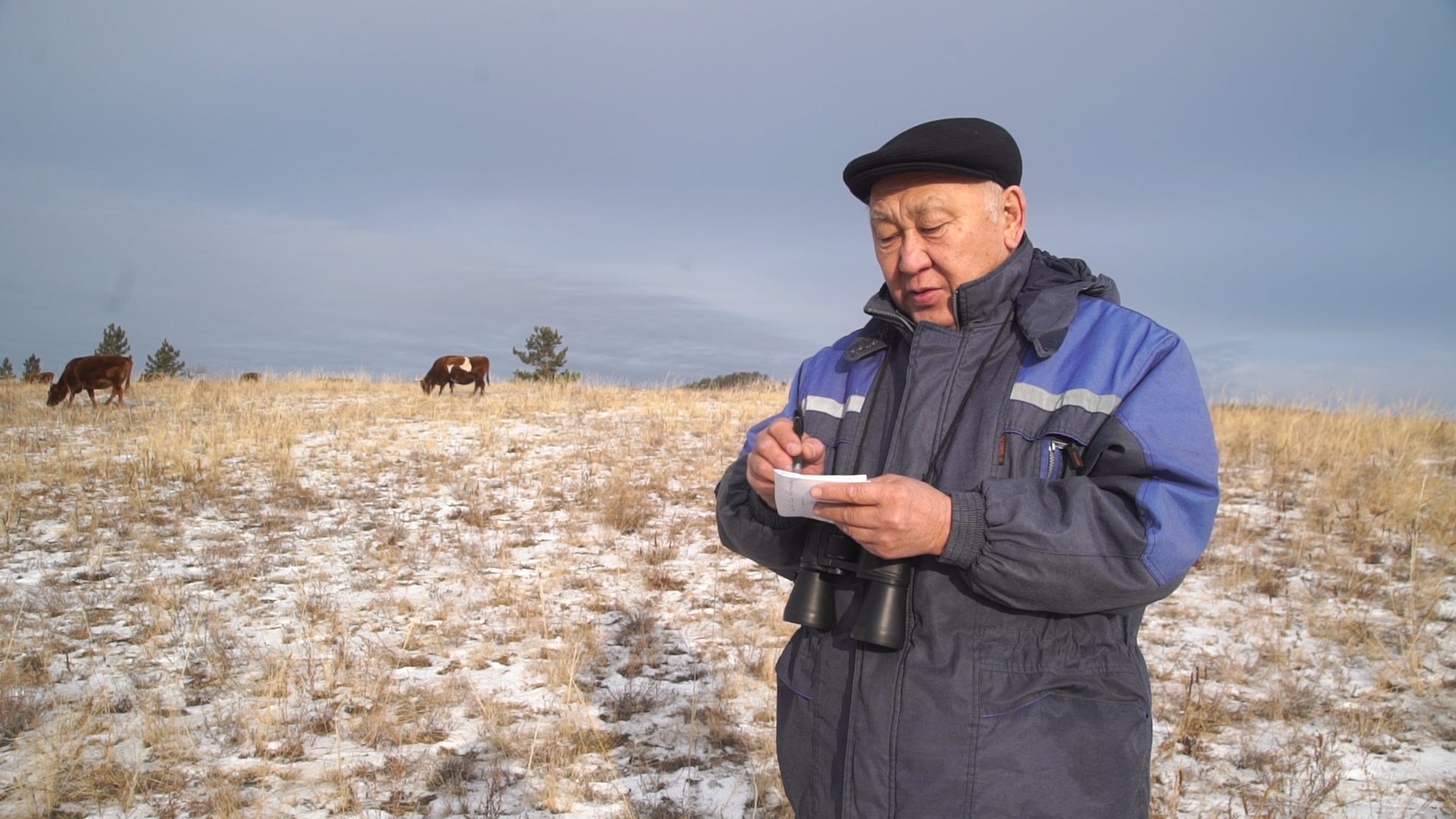
The Peace Building Center supports learning and exchange between pastoralists, veterinarians, and genetic scientists to revive populations of native livestock. Photo by Alexandr Khamaganov.
The Buryat cattle population is growing, but is currently only 300-head strong. Visiting Siberian herders, veterinarians, and scientists marveled at the ways that the Mongolians have safeguarded nomadic pastoralist culture. They took part in a branding ritual that demonstrated the Mongolians’ spiritual connection with their animals and landscape, which the Siberians seek to revive in their own country. Through learning exchanges like these, Indigenous Peoples from across the Pamir, Tien-Shan, and Sayan-Altai regions engage in intergenerational and cross-border transfers of knowledge.
Throughout the world, the biodiversity of the planet’s flora and fauna is being lost at an alarming rate. The Food and Agriculture Organization estimates that nearly 30 percent of all native livestock breeds are currently at risk of extinction. At the same time, recent research finds that Indigenous Peoples protect nearly 80 percent of the world’s remaining biodiversity, despite comprising less than 5 percent of the world’s population and managing only a quarter of the planet’s territory. The fragile ecological balance they maintain ensures our planet remains habitable.
The pandemic, wrought in part by our industrialized food system, has forced a rethink of priorities, said Raimberdieva. Her country, Kyrgyzstan, was confronted by its dependence on food imports and lack of food security. “Many communities have realized the need to survive at the level of local landscapes, local social networks, and natural systems of values and priorities. We now respect the efforts of livestock breeders, farmworkers, hunters, craftsmen, and all others who create things with their own hands to the benefit of themselves and the others.”
Respecting these communities and their practices helps us all. A recent report by the Intergovernmental Panel on Climate Change emphasizes that improved landscape stewardship of the sort practiced by the nomadic pastoralists in Central Asia is fundamental to cool the planet. When Buryat bovines are thriving once again, strengthening genetic biodiversity, agroecological herding practices across Central Asia, and territorial integrity, we will be a step closer to a healthier, more resilient future.
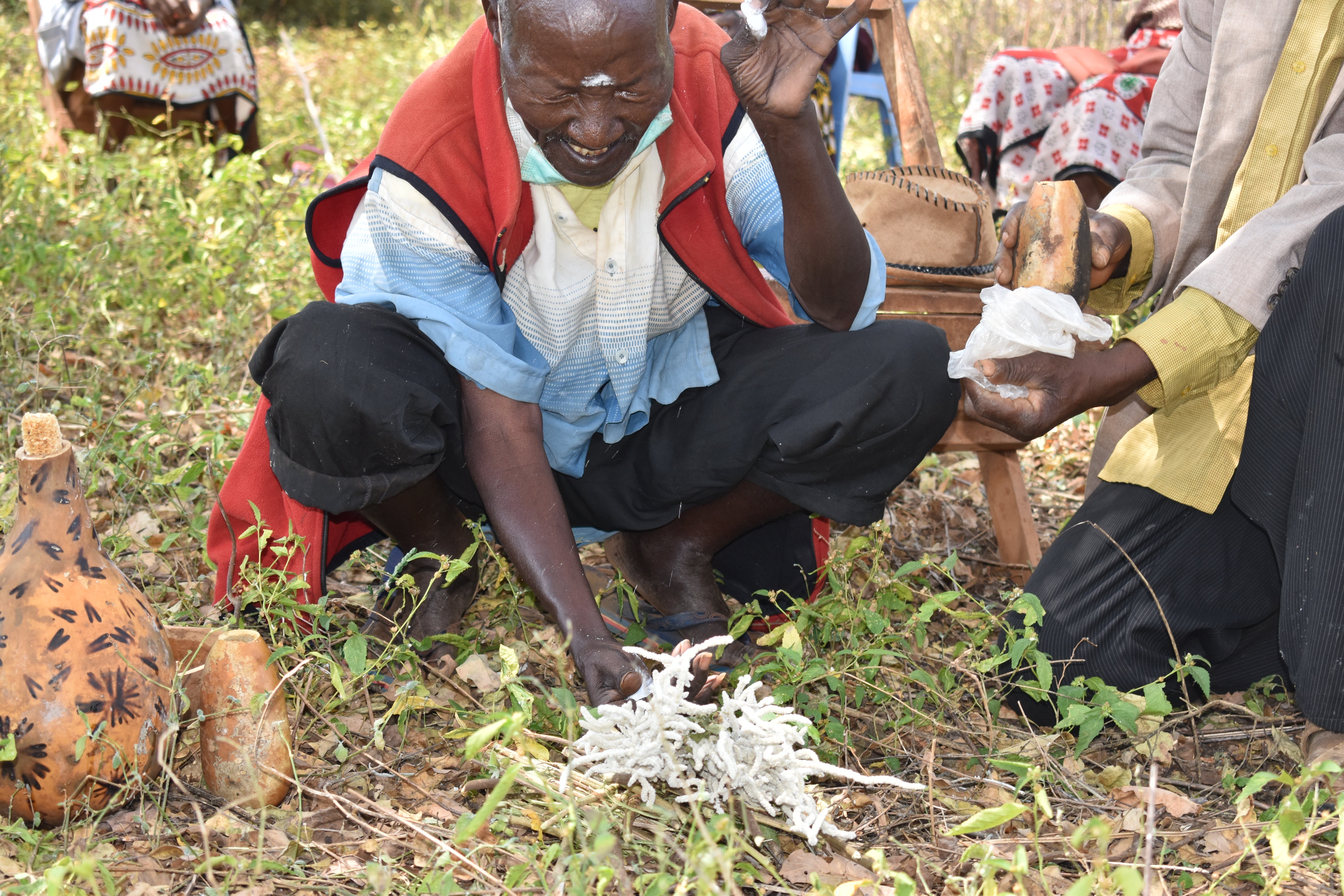
The African Biodiversity Network helps youth learn about traditional foods and plants from their elders. Photo by Simon Mitambo.
Africa
Eastern Kenya is a dusty red landscape where communities herd livestock and grow much of their food in small gardens and fields, working communally at harvest season. Like the rest of the world, COVID-19 has disrupted ways of life here. People’s movements are limited by a government curfew; they cannot reach their fields to harvest their crops, graze animals, or save seeds, and gathering to help at neighboring farmsteads is no longer possible. The risk of hunger is very real. But for now, Indigenous communities have come together to support each other and those who cannot grow their own food.
The pandemic has also revived age-old traditions, bringing a newfound respect for inter-generational knowledge. In recent weeks, the Mijikenda, Kikuyu, Kamba, Maasai, and Tharaka Elders held separate ceremonies to invoke ancestors’ help, as reported in The Star. In Tharaka, Elders performed a ritual known as Muriira to build solidarity and protect the community from the coronavirus. Traditionally, Tharakan Elders would conduct the Muriira when they learned about an illness or pestilence originating in neighboring areas and communities that could pass into Tharakan territory.
“We have our own traditional ways of responding to these events that have helped us to be resilient in the face of many challenges. These traditional responses are part of the reason the Tharakan people are still here, despite huge locust swarms that have threatened our crops and diseases like chickenpox that have threatened our people,” wrote Simon Mitambo, in a piece for Terralingua. Mitambo is the Regional Program Coordinator of the African Biodiversity Network, a regional network of organizations seeking African solutions to the environmental and socio-economic challenges that face the continent. The African Biodiversity Network seeks to advance Indigenous knowledge, ecological agriculture, and biodiversity related rights.
As part of the Muriira ritual, people prepare locally grown varieties of millet and gather fortifying wild herbs for the Elders to use. Women and men from the community prepare large batches of gruel made with the seeds and local honey. With the ritual dish, the Elders visit homesteads throughout the territory to ward off threats and pray for restored ecological balance. This year, the ritual was adapted for social distancing.
For decades, traditional governance has been at odds with mainstream governance. Colonial education and Western missionaries have eroded traditional Kenyan culture and confidence. What is particularly extraordinary is that the ritual has created harmony within the Tharakan community. Some Christians, who are usually hostile to the Elders who continue to practice traditional spirituality, even donated seeds and herbs to the ritual. “This surprised me, and I asked the Elders why. They said it is because in this time of crisis, their minds appear to be opening to the ways of their forefathers. They seem to be seeing the value in our rituals and what they can do for us again,” said Mitambo.
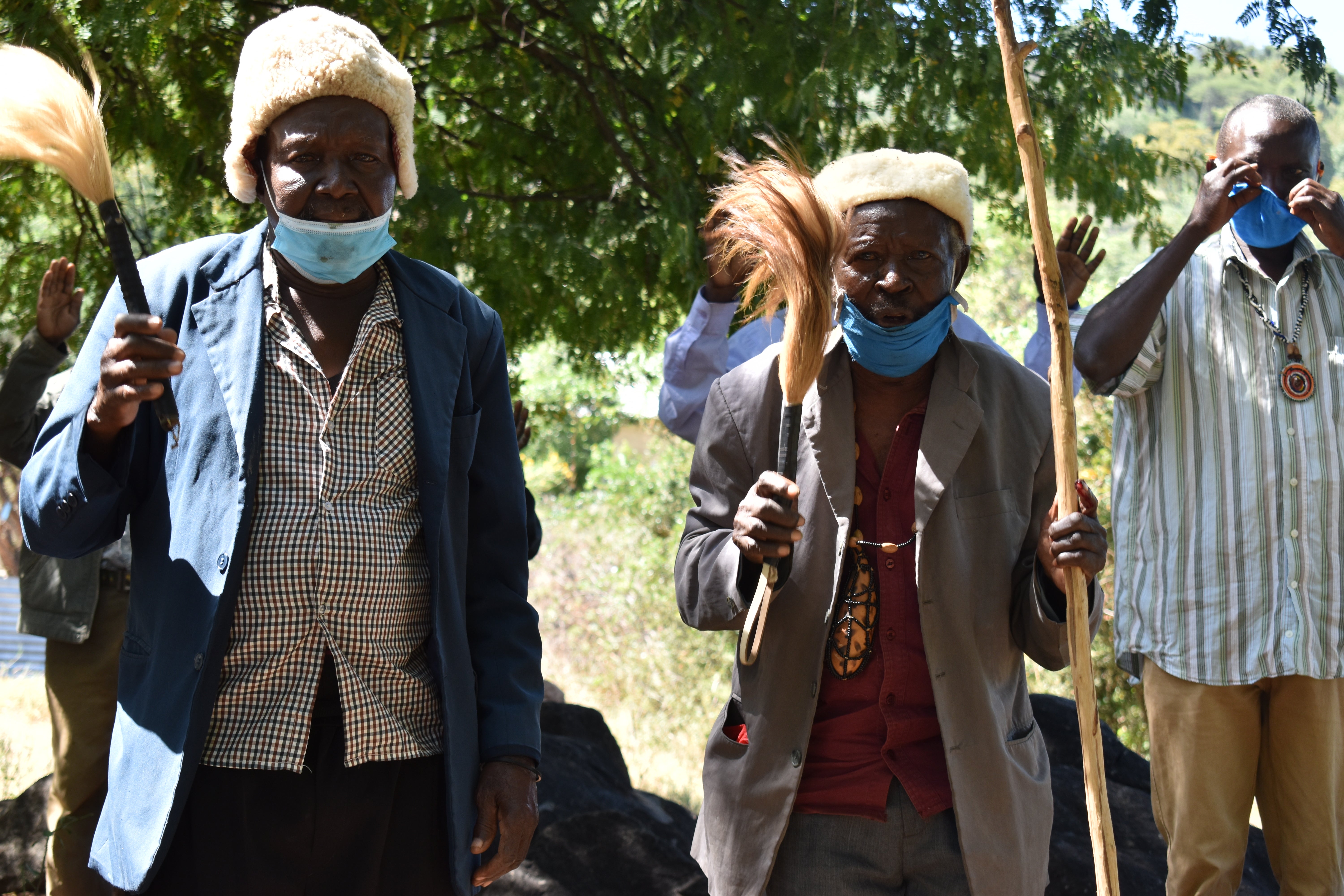
Tharakan elders conduct a ritual to protect their communities from the coronavirus. Photo by Simon Mitambo.
Through the African Biodiversity Network, Elders from different clans and communities have begun to engage with children and youth in schools, so that they may gain some ancestral knowledge in addition to their formal education. In recent years, there has been a revival of Indigenous foods and practices; traditional foods and heritage seeds are returning to these communities. Indigenous seeds are best suited to the land and rapidly changing climate in this region, and people who revived these seeds receive good harvests and eat well. There is more awareness among the youth that their traditional foods are nourishing and build immunity. Changes have begun to be seen at the landscape level as well. The Elders helped identify sacred natural sites, and through community dialogues, people remembered how the rivers and plains looked a long time ago and made plans to revive these places, reinstating the traditional laws that protected them for hundreds of years.
The return of the Muriira and the ways it is engaging communities is a sign of something bigger still: a tide turning against the industrialized colonial practices that have long exploited Indigenous territories. Tharakan Elders remind us that just as all our ancestors once did, if we really want to survive on this planet, we must be wary of outsiders claiming their foods and technology will save us, and look out for each other as we live in harmony with nature.
What Lies Ahead
The COVID-19 crisis lays bare our dependence on an unreliable globalized food system. The history is well known: Western models of industrial agriculture have systematically dismantled and erased Indigenous traditions. With the instability caused by COVID-19, the United Nations warns that global hunger is expected to double by the end of 2020. New technologies can of course be helpful, but only if they uphold the message of Indigenous communities— our survival depends upon strong ties to community and Mother Nature.
Learning to honor that cultural fabric and strengthen nature-based farming lies at the heart of a global agroecology movement. The Indigenous communities described here are core to that wide-ranging, diverse movement. At a recent Agroecology Fund global gathering, participants from the Potato Park, the Peace Building Center, and The African Biodiversity Network had the opportunity to exchange knowledge and experiences with agroecology practitioners from around the world, while learning from their colleagues in India, who are participating in a dynamic, state-supported natural farming program.
Collective action to amplify agroecology and change how we feed our communities in these uncertain times is critical. The Agroecology Fund facilitates opportunities for dialogue, debate, and advocacy, to strengthen the connections among agroecology practitioners, researchers, donors, and policymakers. At the upcoming UN Convention on Biological Diversity Conference of Parties in Kunming, China, in 2021, these Indigenous-led groups will seek to enforce the UN Declaration on the Rights of Indigenous Peoples, a key organizing mechanism to express their communities’ priorities, worldviews, and collective identities. When we bring Indigenous worldviews back from the margins and hold them up at the center, a just and equitable food system will be within reach.
— Amrita Gupta leads communications at the Agroecology Fund; Daniel Moss is the executive director of the Agroecology Fund; Simon Mitambo is regional program coordinator of the African Biodiversity Network; and Cass Madden is senior researcher at Asociación ANDES. This article was written in collaboration with the Agroecology Fund.
Top photo: For the Quechua community in the Andes, the potato is food, medicine, and a cultural symbol. Photo courtesy of Potato Park.
